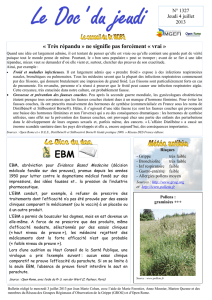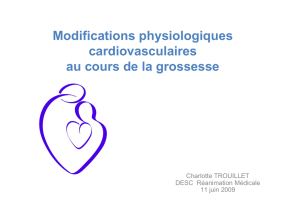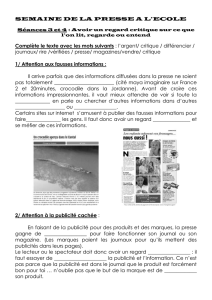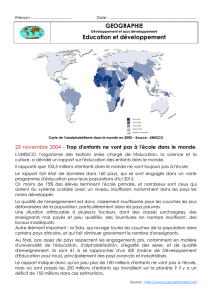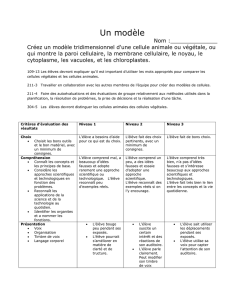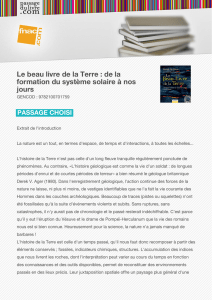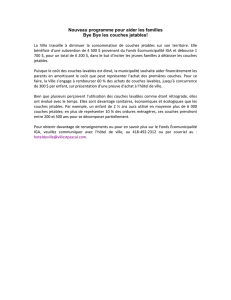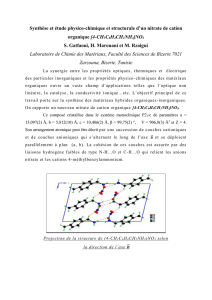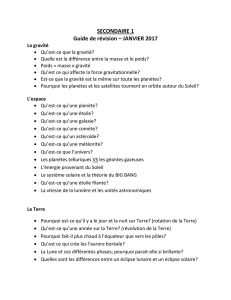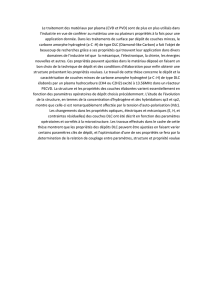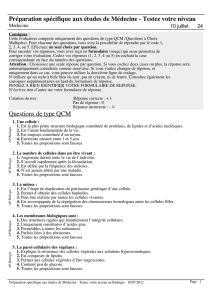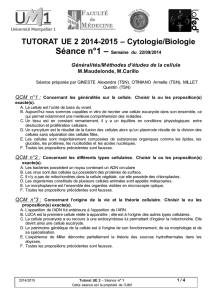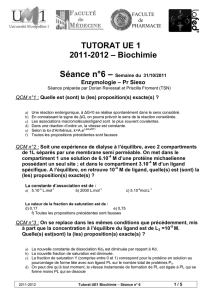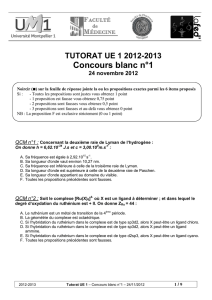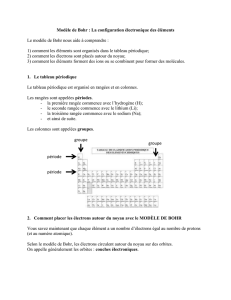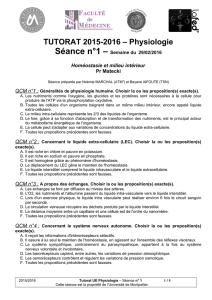Cours DES Fausses couches
publicité
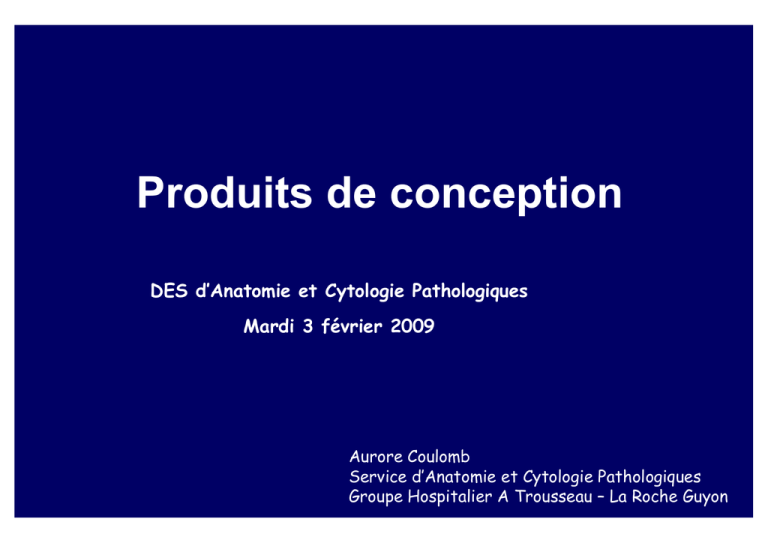
Produits de conception DES d’Anatomie et Cytologie Pathologiques Mardi 3 février 2009 Aurore Coulomb Service d’Anatomie et Cytologie Pathologiques Groupe Hospitalier A Trousseau – La Roche Guyon Méthode d’examen • Poids • cavité ovulaire intacte Vésicule amniotique – taille – embryon • examen • LCC • nuque Vésicule vitelline – cordon – vésicule vitelline • débris : placenta, caduque, embryon • caryotype (récidive de fausse couche) • histologie : placenta, embryon, caduque DEFINITIONS • Fausse couche spontanée – perte embryo-foetale spontanée • Fausses couches spontanées récidivantes – nomenclature : fausse couche récurrente – 3 ou plus pertes spontanées [consécutives, non consécutives] • primaire : pas de naissance vivante • secondaire : fausses couches récidivante après naissance vivante – Représentent 3% des fausses couches spontanées • Fausse couche spontanée précoce – avant 14 SA (1er trimestre) • Fausse couche spontanée tardive FCT – entre 14-20 SA (début 2ème trimestre, période pré viabilité; pour certains auteurs jusqu’à 24 SA) Fausses couches MECHANISMES • MATERNELLE – SYSTEMIQUE • GENETIQUE (5%) • IMMUNOLOGIQUE (5-25%) • HORMONAL (20-40%) – LOCAL • ANATOMIQUE (10-20%) • PATERNELLE – SYSTEMIQUE (GENETIQUE) (Part of 5%) • ENVIRONMENTAL – TOXIQUE (Rare) – INFECTIEUX (1-5%) • INCONNU (20-60%) FAUSSES COUCHES MECHANISMES MATERNELS • SYSTEMIQUE – GENETIQUE = CHROMOSOMIQUE • anomalie gamétogenèse : non disjonction chromosomique • translocations familiales déséquilibrées (5%) PRE-MOM MERE BABY PERE FAUSSES COUCHES HISTOLOGIE • SYSTEMIQUE – GENETIQUE = CHROMOSOMIQUE • trisomie, translocation (5%) • Perte embryonnaire précoce (œuf clair, embryon nodulaire) – défaut vascularisation allanto-chorial – défaut de production des CSH • Anomalies de l’embryon Fausses couches MECHANISMES MATERNELS • SYSTEMIQUE – ANOMALIES GENETIQUES AUTRES = GENE (RARE) • EMPREINTE – Mole hydatiforme récurrente – pertes précoces récurrentes • MOSAÏQUE – syndrome du QT long – Mosaiques hétérozygotes mutation SCN5A – Late recurrent loss (3rd trimester, newborn) • HOMOZYGOUS – ex SICKLE CELL DISEASE – Fausses couches • POLYMORPHISME – ex Cytokine Th1 – augmentation production interféron (IFN)-gamma Fausses couches MECHANISMES MATERNELS - EMPREINTE mole hydatiforme partielle et complète Choriocarcinoma Fausses couches MECHANISMES MATERNELS • SYSTEMIQUE • IMMUNOLOGIQUE (5-25% des fausses couches récurrentes) • Héréditaires • THROMBOPHILIES - MUTATION FACTOR V LEIDEN - MUTATIONS FACTOR II (PROTHROMBIN) MUTATION - MUTATION METHYLENETETRAHYDROFOLATE REDUCTASE (MTHFR) - DEFICIT EN ANTITHROMBIN III - DEFICIT EN PROTEIN S - DEFICIT EN PROTEIN C - DYSFIBROGENEMIIE - HYPERHOMOCYSTEINEMIA (1+) Pertes fœtales tardives (3ème trimester, newborn) • Thromboses sous choriale massive THROMBOPHILIE Thrombose sous choriale massive Thrombose sous choriale massive Thrombose sous-choriale massive FAUSSES COUCHES MECHANISMES MATERNELS • SYSTEMIQUE • IMMUNOLOGIQUE • héréditaires • acquise • HORMONAL - insuffisance lutéale Fausse couche spontanée - syndrome des ovaires polykystiques • AUTOIMMUNE = HUMORAL - diabète (vasculopathie) - Ac antophospholipides (anticardiolipines, anticoagulant lupique) - Ac antithyroidien - résistance à la protéine C • Vasculopathie, hypotrophie fœtale et placentaire, infarctus placentaire (rare au 1er trimestre), éclampsie •“Maternal floor infarction ou NIDF basale avec RCIU •Thrombose sous choriale massive (Ac antiphospholipide) via ANTI-b2-GLYCOPROTEINE-1 • ALLOIMMUNE = CELLULAR (MECHANISME PAS CONNU) • intervillite chronique massive ? • MFI/NIDF basale ? AUTOIMMUNE infarctus placentaires Lupus anticoagulant AUTOIMMUNE / ALLOIMMUNE MATERNAL FLOOR INFARCION (MFI) / NIDF BASALE NIDF MFI ALLOIMMUNE intervillite chronique massive MHC intervillite chronique massive FAUSSES COUCHES MECHANISMES MATERNELS • LOCAL – ANATOMIQUE ( 10-20% des fausses couches récurrentes) • CONGENITAL = MULLERIAN – – – – – utérus unicorne Anomalie de la configuration utérus bicorne placentaire utérus didelphe Déformations cloison utérine utérus en T, béance cervicale (exposition congénitale au diethylstilbesterol DES) • ACQUISES – – – – – SYNECHIE UTERINE BEANCE CERVICALE (ex après conisation) LEIOMYOME POLYPES de L’ENDOMETRE MALADIES INFLAMMATOIRES PELVIENNES Anomalie de la configuration placentaire Déformations Fausses couches : ANATOMIQUES CONGENITAL = MULLERIAN Corne utérine rudimentaire uterus bicorne Utérus didelphe Fausses couches : ANATOMIQUES : ACQUISES Béance cervicale CAOS Fausses couches ACQUIS Béance cervicale Grossesse ectopique tubaire Fausse couche AUTRES MECHANISMES • PATERNEL (5%) – SYSTEMIQUE = GENETIQUE • Translocation équilibrée Fausse couche précoce (œuf clair, embryon nodulaire) anomalie embryon/fœtus • BIPARENTAL – SYSTEMIQUE • CHROMOSOMIQUE – AUTOSOMIQUE RECESSIF anomalie spécifique • ? IMMUNE – incompatibilité parentale allogénique – hypothèse, non prouvé Histologie ? Maladies AR Nanisme thanatophe AD (not AR) OI type II syndrome d’Apert Maladies AR Syndrome létal des pterygium multiples Fausses couches MECHANISMES ENVIRONNEMENTAUX • TOXIQUES Inhalation ex FORMALDEHYDE, XYLENE Ingestion ex ALCOHOL, COCAINE, METHOTREXATE, METAUX LOURDS Agents physiques ex chaleur, RI • présent dans l’environnement • présent in vivo • exposition maternelle congénitale (ex DES) MALFORMATIONS • INFECTIONS (1-5% des fausses couches récurrentes) • AGENTS • BACTERIES: L. monocytogenes, M. hominis, U. urealyticum, Group B streptococcus, C. trachomatis, T. pallidum, B. burgdorfei • VIRUS : Herpes simplex virus (HSV), Cytomegalovirus (CMV) • systemic infection systémique • infection locale ex chronic endométrites chronique • MALADIE INFLAMMATOIRE PELVIENNE Fausses couches MECHANISMES, MORPHOLOGIE • MATERNELLE – SYSTEMIQUE • GENETIQUE précoce, malformations • IMMUNOLOGIC précoce-tardif, normal (RCIU) • HORMONAL précoce, normal – LOCALE • ANATOMIQUE précoce tardif, DEFORMATIONS • PATERNELLE – SYSTEMIQUE (GENETIQUE) précoce, malformations • ENVIRONMENTALE – TOXIQUE MALFORMATIONS – INFECTEUX perte précoce - tardif • inconnue Fausses couches MECHANISMES INCONNUS Cordon excessivement spiralé Fausses couches Données cliniques • Fausses couches précoces avec caryotype anormal : 50-70% – – – – – trisomie: 50-55% (trisomie 16, 13, 15, 21, 22 ) non disjonction chromosomique Monosomie X: 15-25% Triploïdie: 15-20% accident fécondation Anomalies de structure : 2-10% Tetraploidie: 5% • Fausses couches tardives avec caryotype anormal : 7-10% • Fausses couches récurrentes : 1% – risque 1ère or 2ème FCS = 15%, après 2ème FCS = 25%, après 3ème FCS = 33% – grossesse à terme après 3 fausses couches si pas de cause identifiée et sans traitement spécifique : 50-70% Bibliographie REVUES 1. Genest DR. The pathology of pregnancy waste. Adv in Pathol and Lab Med 7:281-312, 1994. 2. Diejomaoh MF et al. The aetiology and pattern of recurrent pregnancy loss. J Obstet Gynaecol 22(1): 62-67, 2002. 3. Katz VL and Kuller JA. Recurrent miscarriage. Am J Perinatol 11(6):386-397, 1994. 4. Scott JR. Recurrent miscarriage: overview and recommendations. Clin Obstet Gynecol 37(3): 768-773, 1994. 5. Hatasaka HH. Recurrent miscarriage: epidemiologic factors, definitions, and incidence. Clin Obstet Gynecol 37(3): 625-634, 1994. Caryotype 1. Genest DR. Fetoplacental histology as a predictor of karyotype: a controlled study of spontaneous first trimester abortions. Hum Pathol 26:201-209, 1995. 2. Hogge WA. The clinical use of karyotyping spontaneous abortions. Am J Obstet Gynecol 189(2):397400, 2003. 3. Redline RW et al. Prevalence of developmental and inflammatory lesions in nonmolar first-trimester spontaneous abortions. Hum Pathol 30(1):93-100, 1999. THROMBOPHILIE 1. Adelberg AM, Kuller JA. Thrombophilias and recurrent miscarriage. Obstet Gynecol Surv 57(10):703709, 2002. 2. Brenner B. Inherited thrombophilia and pregnancy loss. Best Pract & Res Clin Haematol 16(2):311-320, 2003. Bibliographie THROMBOPHILIE 1. Dilley A et al. Mutations in the factor V, prothrombin and MTHFR genes are not risk factors for recurrent fetal loss. J Matern Fetal Med 11(3):176-182, 2002. 2. Dudding TE, Attia J. The association between adverse pregnancy outcomes and maternal factor V Leiden genotype: a meta-analysis. Thromb Haemost 91(4):700-711, 2004. 3. Heller DS et al. Subchorionic hematoma associated with thrombophilia: report of three cases. Pediatr Dev Pathol 6(3):261-264, 2003. 4. Hohlagschwandtner M et al. Combined thrombophilic polymorphisms in women with idiopathic recurrent miscarriage. Fertil Steril 79(5):1141-1148, 2003. 5. Kovalesky G et al. Evaluation of the association between hereditary thrombophilia and recurrent pregnancy loss: a meta-analysis. Arch Intern Med 164(5):558-563, 2004. 6. Krabbendam I, Dekker GA. Pregnancy outcome in patients with a history of recurrent spontaneous miscarriages and documented thrombophilias. Gynecol Obstet Invest 57(3):127-131, 2004. 7. Rey E et al. Thrombophilic disorders and fetal loss: a meta-analysis. Lancet 361(9361):901-908, 2003. 8. Roque H et al. Maternal thrombophilias are not associated with early pregnancy loss. Thromb Haemost 91(2):290-295, 2004. 9. Wolf CE et al. Recurrent pregnancy loss and its relation to FV Leiden, FII G20210A and polymorphisms of plasminogen activator and plasminogen activator inhibitor. Pathophysiol Haemost Thromb 33(3):134137, 2003. Bibliographie SYNDROME des ANTIPHOSPHOLIPIDES 1. Balasch J. Antiphospholipid antibodies: a major advance in the management of recurrent aboriton. Autoimmun Rev 3(3):228-233, 2004. 2. Dunoyer-Geindre S et al. Aspirin inhibits endothelial cell activation by antiphospholipid antibodies. J Thromb Haemost 2(7):1176-1181, 2004. 3. Gezer S. Antiphospholipid syndrome. Dis Mon 49(12):696-741, 2003. 4. Grover R, Kumar A. The antiphospholipid syndrome. Natl Med J India 16(6):311-316, 2003. 5. Lee RM et al. Homocysteine levels in women with antiphospholipid syndrome and normal fertile controls. J Reprod Immunol 63(1):23-30, 2004. 6. Lockshin MD. Antiphospholipid antibody: babies, blood clots, biology. JAMA 277(19)1549-1551, 1997. 7. Nayar R, Lage J. Placental changes in a first trimester missed abortion in maternal systemic lupus erythematosus with antiphosholipid syndrome: a case report and review of the literature. Hum Pathol 27:201-206, 1996. 8. Ornoy A et al. Maternal autoimmune diseases and immunologically induced embryonic and fetoplacental damage. Birth Defects Res Part A Clin Mol Teratol 70(6):371-381, 2004. 9. Oshiro BT et al. Antiphospholipid antibodies and fetal death. Obstet Gynecol 87:489-493, 1996. 10. Salmon JE, Girardi G. The role of complement in the antiphospholipid syndrome. Curr Dir Autoimmun 7:133-148, 2004. 11. Van Horn JT et al. Histologic features of placentas and abortion specimens from women with antiphospolipid and antiphospolipid-like syndrmoes. Placenta 25(7):642-648, 2004. Bibliographie INFECTION 1. Gaytant MA et al. Congenital cytomegalovirus infection after recurrent infection: case reports and review of the literature. Eur J Pediatr 162(4):248-253, 2003. 2. Redline RW. Recurrent villitis of bacterial etiology. Pediatr Pathol Lab Med 16(6):995-1001, 1996. 3. Summers PR. Microbiology relevant to recurrent miscarriage. Clin Obstet Gynecol 37(3):722-729, 1994. MATERNAL FLOOR INFARCTION/NIDF BASALE 1. Bane AL, Gillian JE. Massive perivillous fibrinoid causing recurrent placental failure. BJOG 110(3):292295, 2003. 2. Bendon RW, Hommel AB. Maternal floor infarction in autoimmune disease: two cases. Pediatr Pathol Lab Med 16(2):293-297, 1996. 3. Katz VL et al. Activated protein C resistance associated with maternal floor infarction treated with low molecular weight heparin. Am J Perinatol 19(5):273-277, 2002. 4. Katzman PJ, Genest DR. Maternal floor infarction and massive perivillous fibrin deposition: histological definitions, association with intrauterine fetal growth restriction, and risk of recurrence. Ped Dev Pathol 5:159-164, 2002. 5. Redline RW et al. Discordancy for maternal floor infarction in dizygotic twin placentas. Hum Pathol 34(8):822-824, 2003. 6. Sebire NJ et al. Placental pathology, antiphospholipid antibodies, and pregnancy outcome in recurrent miscariage patients. Obstet Gynecol 101(2):258-263, 2003. Bibliographie INTERVILLITE CHRONIQUE MASSIVE 1. Boyd TK, Redline RW. Chronic histiocytic intervillositis: a placental lesion associated with recurrent reproductive loss. Hum Pathol 31(11):1389-1396, 2000. 2. Doss BJ et al. Massive chronic intervillositis associated with recurrent abortions. Hum Pathol 26:12451251, 1995. 3. Jacques SM, Qureshi F. Chronic intervillositis of the placenta. Arch Pathol Lab Med 117:1032-1035, 1993. 4. Labarrere C, Mullen E. Fibrinoid and trophoblastic necrosis with massive chronic intervillositis: an extreme variant of villitis of unknown etiology. Am J Reprod Immunol Microbiol 15(3):85-91, 1987. 5. Nijhuis EWP, vanNort G. Clinicopathological correlations in chronic intervillositis. Ped Dev Pathol 1:457, 1998. 6. Ordi et al. Massive chronic intervillositis of the placenta associated with malaria infection. Am J Surg Pathol 22(8):1006-1011, 1998. FAUSSE COUCHE ET GENETIQUE 1. Al-Hussaini TK et al. Recurrent pregnancy loss due to familial and non-familial habitual molar pregnancy. Int J Gynaecol Obstet 83(2):179-186, 2003. (see additional references in GTD lecture) 2. Daher S et al. Cytokines in recurrent pregnancy loss. J Reprod Immunol 62(1-2):151-157, 2004. 3. Prigoshin N et al. Cytokine polymorphisms in recurrent pregnancy loss of unknown cause. Am J Reprod Immunol 52(1):36-41, 2004. 4. Miller TE et al. Recurrent third-trimester fetal loss and maternal mosaicism for long QT syndrome. Circulation 109(24:3029-3034, 2004. 5. Serjeant GR et al. Outcome of pregnancy loss in homozygous sickle cell disease. Obstet Gynecol 103(6):1278-1285, 2004. Bibliographie REVUES DIVERS 1. Brent RL, Beckman DA. The contribution of environmental teratogens to embryonic and fetal loss. Clin Obstet and Gynecol 37(3):646-670, 1994. 2. Patton PE. Anatomic uterine defects. Clin Obstet and Gynecol 37(3):705-721, 1994. TRAITEMENT 1. Bats AS et al. Antiphospholipid syndrome and second or third trimester death: follow-up in the next pregnancy. Eur J Obstet Gynecol Reprod Biol 114(2):125-129, 2004. 2. Kuttek WH. Antiphospholipid antibody-associated recurrent pregnancy loss: treatment with heparin and low dose aspirin is superior to low dose aspirin alone. Am J Obstet Gynecol 174:1584-1589, 1996. 3. Scott JR. Immunotherapy for recurrent miscarriage. Cochrane Database Syst Rev (1):CD000112, 2003. 4. Stagnaro-Green A, Glinoer D. Thyroid autoimmunity and the risk of miscarriage. Best Pract Res Clin Endocrinol Metab 18(2):167-181, 2004.
